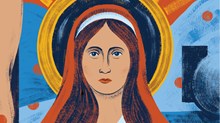At his death in 1434, a "London wax-chandler" named Roger Elmsley bequeathed to "a favourite godchild 'a prymmer to serve God with,' " a prayer book small enough to be tucked into a capacious medieval sleeve or worn on the belt, the way people today wear cell phones. Such prayer books, some of them much more elaborate and unwieldy than the popular pocket versions, were keyed to the daily offices—hence the generic term "Book of Hours," by which they were known. In his new book, Marking the Hours: English People and Their Prayers, 1240-1570,, Eamon Duffy considers these aids to devotion from many different angles, opening windows on medieval piety and provoking reflection on our own devotional practices.
Duffy is best known for The Stripping of the Altars: Traditional Religion in England, 1400-1580, a bold and massive revisionist account of the English Reformation, first published by Yale University Press in 1992 and issued in a revised edition in 2005. He is a practicing Catholic as well as an accomplished historian.
While writing The Stripping of the Altars, Duffy began to study Books of Hours, so that his new book might be regarded as a pendant to that groundbreaking work. These prayer books were at first exclusively in Latin, then gradually incorporated bits of the vernacular. They were centered on the Psalms but also included prayers to the Virgin Mary, whose presence in medieval piety was enormous, and could contain many other aids to devotion, such as the revelations of St. Brigid—not the Irish saint, c. 450-c.525, but rather the 14th-century Swedish mystic and reformer.
Originally the prerogative of the wealthy, which would commission lavish illuminated volumes designed to their specifications, Books of Hours became more affordable, first through standardized manuscript versions and then with the advent of printing. Duffy reports that about 800 manuscript volumes survive, and many more printed texts (many of them quite beautiful in their own right). One of the glories of Marking the Hours is the abundant selection of illustrations. Indeed, the book is superbly produced, with one caveat: on all the copies I have seen, the boards are splayed, the more so as the book is handled and read.
Duffy takes particular notice of the way users of these books modified them—through marginalia, changes in the text (the erasure of names of people or formulas of prayer fallen out of favor, for instance), additional pages pasted in, notes on blank pages, drawings and doodlings, in some cases clearly the work of someone other than the original owner. He suggests that such individualized touches afford otherwise inaccessible insight into the minds of medieval readers. Given the relatively small sample he's dealing with, Duffy's claims for the significance of these modifications seem a bit exaggerated. His main argument doesn't depend upon this point, however. What we learn, unsurprisingly, is that Books of Hours contained a mixture of orthodox Christian piety with the accretions that helped to provoke the Reformation—prayers "straddling the dividing line between magic spell and petitionary prayer," as Duffy nicely puts it, and sometimes obliterating that line altogether.
It would be interesting to consider 21st-century American evangelical prayer practice and aids to devotion in the light of these medieval counterparts. What accretions might be apparent to an observer from outside the frame of our own cultural context? Are certain naïve assumptions inherited from the Reformation still evident in evangelical conceptions of prayer five centuries down the road?
One example will have to suffice. When I was growing up, I was taught to regard the set prayers of Roman Catholics as the very epitome of dead ritual and mumbo jumbo. (The Lord's Prayer was the exception that proved the rule.) Of course set prayers can be all that, but they can also be an expression of living faith. By the same token, the "spontaneous" prayers of our evangelical Wednesday evening gatherings were often rigidly formulaic, though you couldn't find them in a printed prayer book. In recent years many evangelicals—my wife and I included—have been drawn to prayer books such as Phyllis Tickle's The Divine Hours, using set prayers in a manner that would have been alien to most evangelicals a generation ago.
I finished Duffy's book with the conviction that the medieval Christians whose piety is on display in these pages were very much like us, for all the distance between their world and ours. That we suppose we can speak to God—and he answers us—strikes the confident atheist as simultaneously preposterous and frightening. They think he's up there somewhere, listening to them! So we do, in a manner of speaking, and so did our medieval forebears, one of whose favorite prayers, O Bone Jesu, "approached the divinity like a lover or a family intimate," as Duffy observes: "O good Jesu, o sweet Jesu, … have mercy upon me."
John Wilson is the editor of Books & Culture.
Marking the Hours: English People and Their Prayers, 1240-1570, by Eamon Duffy, may be purchased at ChristianBook.com  and at Amazon.com.
For more information on medieval Christianity, see Christian History & Biography'sissue 49: Everyday Faith in the Middle Ages.
Copyright © 2007 Christian History & Biography, or the author. Click for reprint information.

Support Our Work
Subscribe to CT for less than $4.25/month




























